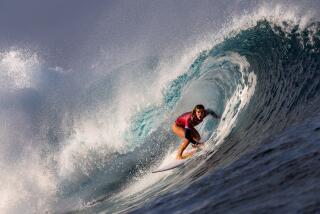Who-what-when-where-why of surfing
Matt Warshaw has a reply ready for critics of his new book: âWrite your own damn encyclopedia.â
But before you get to work on a project as ambitious as the âEncyclopedia of Surfingâ (Harcourt), hereâs what to expect.
First, saw off a year to build in the 1999 version of Filemaker Pro, the worldâs largest database of surf info, gleaned from every niche mag, movie, video and mainstream reference on six continents.
Now, spend six months hunkered down in your San Francisco office agonizing over which 1,500 subjects to include.
Then, hire two staffers to help research and write the final cut -- and still finish a year and a half behind schedule.
âThis was like a four-year, garage-cleaning project,â said Warshaw, 43, a pro surfer turned author of âMaverickâs: The Story of Big-Wave Surfingâ and âSurfRiders.â âI was making lists for months. It sounds incredibly boring, but people should know I wasnât pulling stuff out of thin air.â
Warshaw understands that even someone as fastidious as he is -- all surf mags get clad in hard covers color-coded by title -- canât be error-free, and yet ... âRonnie Burns,â he seethed, reflecting on the omission of the Pipeline surfer who died in 1990. âI still canât figure out how he got crossed off the list.â
Despite the Burns mishap (rectified in âThe Lost Entryâ at right), the 600,000-word, 816-page book is both the old and new testament of board-riding culture, spanning from Captain Cook to Malia Jones. âI really enjoyed [researching] âdog surfingâ or the roots of words like âcowabunga,â which surfers picked up from âThe Howdy Doody Show,â â Warshaw said.
In the bookâs foreword, the New Yorker magazineâs William Finnegan hails Warshaw as a âniche savantâ and a blessing to the sport. Even so, knowing heâs going to take some shots, Warshaw invites disgruntled readers to go on the Web to encyclopediaofsurfing.com with suggestions for the second edition. Or they can write their own encyclopedia.
(BEGIN TEXT OF INFOBOX)
âThe Lost Entryâ: Burns, Ronnie
Quiet, unpretentious pro surfer from the North Shore of Oahu; best remembered as a Pipeline sharpshooter throughout the 1980s, although in fact he was one Hawaiiâs best all-arounders, able to set the pace in gentle three-footers at Rocky Point, or 25-foot monster surf at Waimea Bay. Burns was born (1963) in Newport Beach, California, the son of widely respected surfboard laminator Boscoe Burns; he began riding waves in 1969, at age five, not long after moving with his family to Hawaii. By his late teenage years, the tall (6 feet 2), blond, slightly bow-legged Burns had earned a reputation across the North Shore for his versatile and powerful wave riding. His lines at Pipeline were simple but beautifully plotted, and his success rate in big barrels was untouchable; he was cited as the worldâs second-best Pipeline surfer in a 1989 peer poll, behind Derek Ho and ahead of Tom Carroll. Although he won the 1982 Peru International and the 1987 Xcel Pro, and was Pipeline Masters runner-up in 1985 and 1987, Burns had neither the temperament nor the flash required for a successful pro career. âRonnie Burns doesnât have an image problem,â Surfer magazine wrote of the media-shy goofy-footer in 1987, âbecause Ronnie Burns doesnât have an image.â In the summer of 1990, the 27-year-old Burns died in an off-road motorcycle accident, not far from his home. Burns appeared in more than a dozen surf movies and videos, including Ticket to Ride (1986), Filthy Habits (1987) and Pump! (1990).
-- Matt Warshaw
More to Read
Sign up for our Book Club newsletter
Get the latest news, events and more from the Los Angeles Times Book Club, and help us get L.A. reading and talking.
You may occasionally receive promotional content from the Los Angeles Times.







